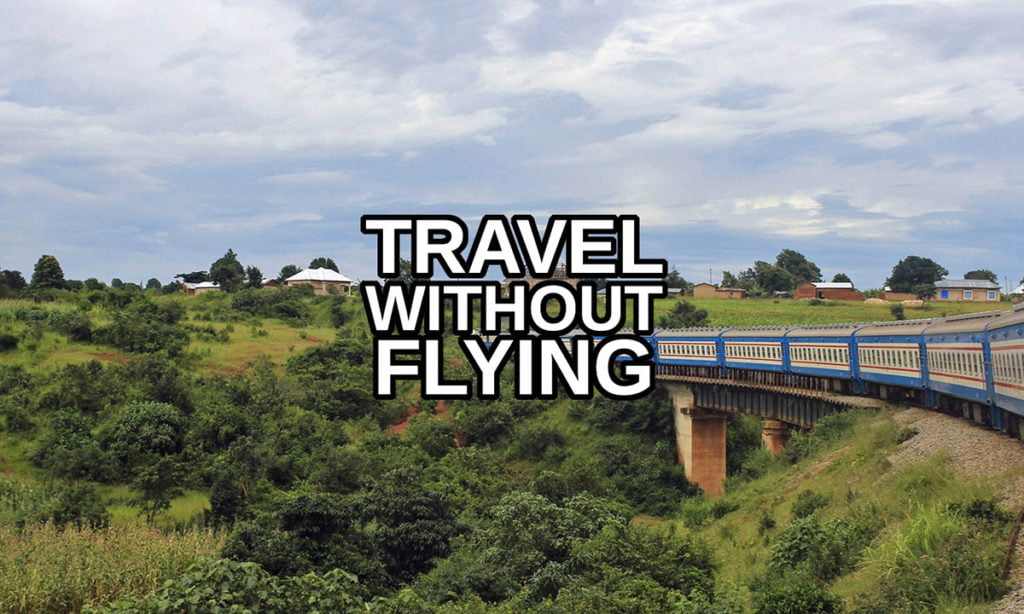How to travel the world without flying? This ultimate guide to flightless travel delves into possibilities across every corner of the globe.
Can you travel around the world without flying? Absolutely! In my previous guide, “How to Travel without Flying,” I shared general tips for flightless travel. Now, in this comprehensive guide called “How to Travel the World without Flying”, we’ll delve into the opportunities and challenges of flightless travel on every continent.
This website, Arimo Travels, is a sustainable travel site I launched back in 2016. Initially, I chronicled my mostly flightless two-year journey around the world. Over time, the focus shifted to sustainable travel tips for destinations worldwide.
This guide is divided into eight sections—one for each continent, plus one for the big picture of how to travel the world without flying. In each part, we explore flightless travel within the continent before detailing flightless routes to/from each continent. In other words, we explore how to explore how to travel everywhere and anywhere without taking a flight.
As you read this guide, you’ll notice that flightless travel can be quite challenging. I understand that many of you may opt to fly occasionally. If you do choose to fly, I kindly request that you offset the CO2 emissions from your flights. To do so effectively, consider donating 10% of your ticket price to a climate nonprofit recommended by Giving Green.
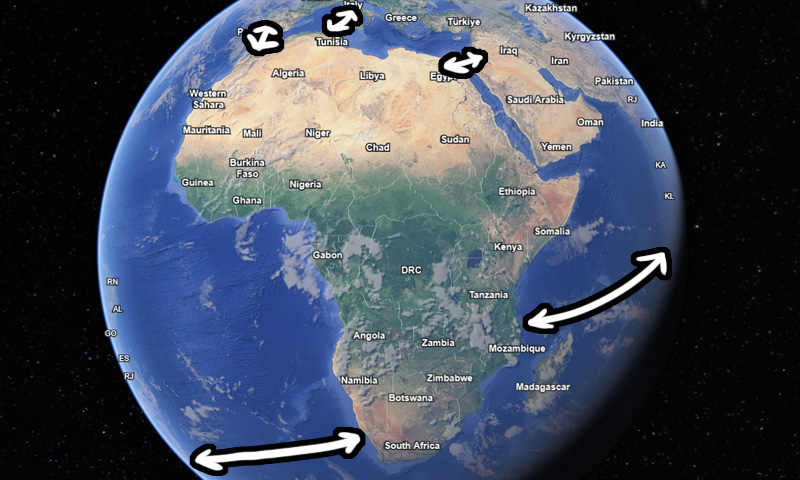
Flightless Travel in Africa
Africa, the second-largest continent, poses challenges to flightless travel due to vast distances and limited tourist infrastructure. However, long-distance public transportation options are available, making it possible to traverse the continent.
I have spent two months exploring the southern and eastern parts of Africa on public transport. For more information about flightless travel in the area, you can read my previous guide “Traveling in Africa on Public Transport“.
How to Travel in Africa without Flying?
Most flightless travelers explore Africa with their own vehicles, though public transport is a viable option. However, obtaining accurate route information can be challenging.
Despite the absence of a Trans-African railway that was first planned in the late 1800s, many African rail routes cover extensive distances. For instance, the TAZARA railway between Tanzania and Zambia allows a 2,000-kilometer journey in approximately 46 hours. I have previously written the guide “Train from Zambia to Tanzania” about the TAZARA train.
Other railway options include traveling through South Africa and continuing to its neighboring countries. There are fewer railway networks in northern Africa, but routes like the famous Iron Ore train in Mauritania offer unique experiences.
Long-distance coaches facilitate travel between different African countries. Ulemu Buses, for example, offers a 1,700-kilometer (1,100 mile) journey from Johannesburg, South Africa, to Blantyre, Malawi, in 24 hours. Further north, a bus from Nairobi, Kenya to Juba, South Sudan crosses 1,100 kilometers (700 miles) in 17 hours and 30 minutes. In general, traveling between countries is easier in southern and eastern Africa.
Flightless Travel Between Africa and Other Continents
Geographically close to Europe, Africa connects seamlessly by crossing the Mediterranean Sea. Ferries operate between Spain and Morocco, as well as Tunisia and Italy. I have previously written two guides on flightless travel between Europe and Africa:
Located in Egypt, the Isthmus of Suez offers a land bridge between Africa and Asia. However, political instability in the Middle East makes flightless travel extremely challenging. Still, my guide on flightless routes to Egypt covers some ways of traveling between Egypt and the Middle East.
Flightless travel between Africa and America is not very common. Although rare, it is possible to sail between Africa and South America. My article on sailing across the Atlantic offers some information about these routes. I haven’t seen any cargo ship connections between Africa and America that would take passengers.
Traveling between Africa and Asia is challenging but feasible. In the past, freighter travel company Slowtravel offered a few cargo ship voyages between Africa and Asia. For example, a journey from Malaysia to Mozambique lasting 24 days cost around €2600. According to Cruiserwiki, sailing from Southeast Asia to Africa is possible from mid-December to late February.

Flightless Travel in North America
North America, comprising Canada, Mexico, the United States, the Caribbean, and Central America, offers extensive opportunities for flightless travel. While the majority of the continent is accessible overland, the Caribbe and and Central America present unique challenges.
I have spent roughly five months exploring North America without flying. I spent most of that in Mexico, and I have a separate guide called “A Short Guide to Overland Travel in Mexico” about flightless travel in that country.
Traveling in North America without Flying
The northern parts of continental North America – Canada, Mexico, and the United States – are favorable for flightless travel. The northern parts of Canada are sparsely populated, but the southern area near the US border is easy to explore, with the Trans-Canada Railway facilitating travel across Canada.
Railways in Mexico and the U.S. are primarily for freight, but Mexico is planning to increase trains for passengers in the upcoming decades. Starting in early 2024, the Tren Maya will connect all major cities in the Yucatán Peninsula. The national railroad company in the US (Amtrak) connects many of the most important regions.
Instead of trains, flightless travel in Mexico and the United States focuses more on long-distance buses. Mexico is covered by several bus companies, many of which are owned by ADO. Meanwhile Greyhound is the most famous coach company in the United States. The coaches in these countries can be very comfortable, and some even have their own on-board entertainment systems like airplanes.
Central America, consisting of seven small countries, features reliable bus services. Smaller countries mean more border crossings, but most of these should be relatively straightforward, and the CA-4 Agreement establishes free movement between four Central American states. According to Wikivoyage, buses are the most popular option for overland travel in the region.
The Caribbean archipelago presents challenges, with ferries connecting some islands but limited options for inter-country travel. Only some countries in the eastern Caribbean are connected by ferries (see map here). If you don’t have your own sailing boat, you can try finding opportunities to work for your passage between islands in local sailing clubs or on websites such as Findacrew.net and CrewSeekers.net.
Flightless Routes Between North America and Other Continents
North America is connected by land to just one other continent, South America. All other continents require ocean crossings.
If you go to Europe, you can travel on a cargo ship or a sailboat across the Atlantic. Luxury cruise ships like Queen Mary 2 serve the route as well, although they produce more CO2 emissions than commercial flights. I have written multiple guides about these routes including “How to Travel from Europe to America by Ship” and “How to Travel from the USA to Europe by Ship“.
Because of the prevailing trade winds, it is more common to sail from Europe to America than the other way around. This route often goes through the Canary Islands and finishes in the Caribbean. The eastward route goes further north from Bermudas towards the Azores. Traveling directly between America and Africa is quite rare, and it is easier to pass through Europe instead.
Flightless travel between Asia and America is less common and takes longer, yet it’s still possible. For example, sailing from California to Japan takes around 30-60 days, and freighter travel company Slowtravel offers a 25-day freighter cruise from Vancouver, Canada, to Tianjing Xingang for around $3000. I have previously published one guide that covers flightless travel from America to Japan.
Traveling to North America also involves a Pacific crossing. I traveled from New Zealand to California on a cargo ship during my 2-year trip around the world, and the freighter’s full route started in Australia. A freighter journey from the US to Australia takes around 25 days, and sailing the same route takes 45-60 days.
Travel between North and South America is generally straightforward, with one major challenge: The Darién Gap on the border of Colombia and Panama breaks the otherwise unified Pan-American Highway. Roads do not pass through this area, and drug cartels make it unsafe for travelers. Although uncomfortable, it is possible to travel between Panama and Colombia by boat.
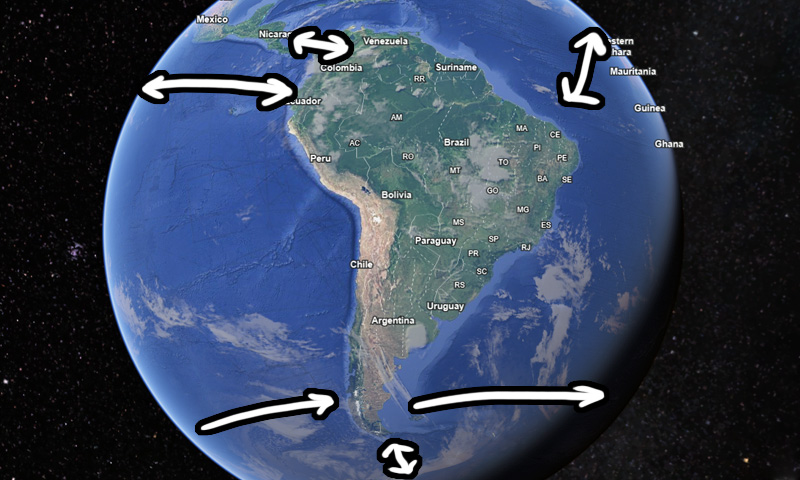
How to Travel the World without Flying: South America
Mountains, rainforests and undeveloped slow down flightless travel in South America. Even if you spent six months in the continent, you’d only cover a tiny speck of its magnitude.
Exploring South America without Flying
According to The Man in Seat 61 – the best resource on train travel online – South America lacks a coherent international rail network, with national rail networks patchy at best. As a sad example, the national railway company of Ecuador went bankrupt during the COVID pandemic. Still, there are some interesting train routes around the continent.
Long-distance buses prove to be the most reliable means of public transportation, navigating challenging terrains. Other options include the Amazon Ferry from Manaus to Macapá. I’ve also known travelers who’ve explored South America with their own motorcycles or even by bicycle.
Spanish is widely spoken in most of South America, emphasizing the value of learning basic phrases for effective communication.
Flightless Travel Between South America and Other Continents
South America’s connection to the rest of the world is not as robust as North America’s. However, it serves as a gateway to Antarctica, with cruises departing from Ushuaia, Argentina, for a 10-15 day tour.
The Darién Gap disrupts overland travel between South and Central America. Sailing or traveling by a speedboat to Central America is possible, although not necessarily comfortable.
Crossing the Atlantic is less popular in the south. Still, it is possible to sail between Africa and South America. The most common route that I’ve seen goes from South Africa to Brazil via St Helena. I haven’t seen any cargo ships that would take passengers between the two continents.
Traveling between South America and Europe on a cargo ship is possible, though. For example, a currently (as of early 2024) inactive service has taken travelers from Hamburg, Germany, to Rio de Janeiro in approximately 20 days, starting at $1700 – a moderate price for a freighter voyage. Another freighter journey even takes travelers between South America and Asia past the southern tip of Africa.
Crossing the Pacific to Asia is an option, although it is easier if you start your journey in North America. A freighter voyage from Ecuador to Japan takes 27 days and costs $2700-3000, but you can cut the journey by almost 10 days and $1000 if you embark in Mexico instead.
Direct sea travel from South America to Australia and Oceania is not common. The prevailing trade winds make it so that it’s easier to start a westward journey to Oceania around Central America. It is possible to sail a southern route from Oceania to South America in 40-50 days or more, although you’d have to endure cold weather with little access to land on the way.
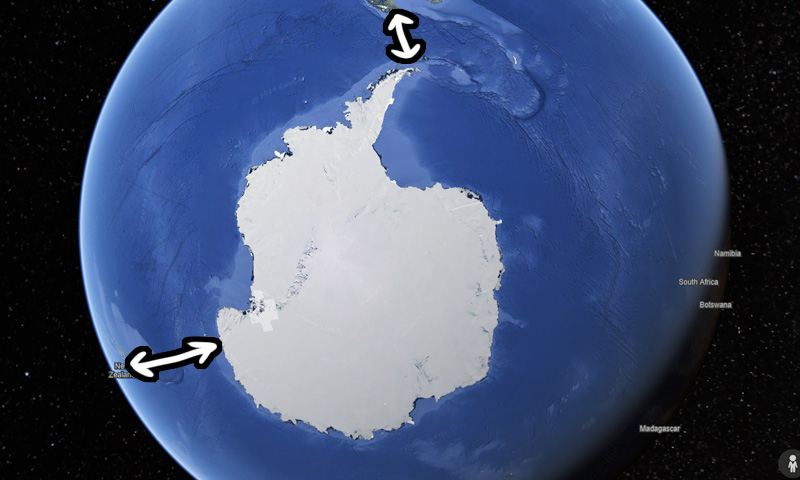
How to Travel to Antarctica without Flying?
Antarctica, a challenging destination, limits exploration by land. However, flightless options exist, focusing on the Antarctic Peninsula.
Exploring Antarctica without Flying
Unless you arrange your own expedition, most of Antarctica remains inaccessible for flightless travel. Union Glacier Camp, the sole commercial camp, is only reachable by plane. While some expensive expeditions allow skiing to the South Pole, they typically involve an initial flight to the continent.
While some extremely expensive expeditions allow skiing all the way to the South Pole, these journeys typically start with a flight to the continent. Fully flightless expeditions begin with a ship from Ushuaia and focus on the Antarctic Peninsula, the northernmost part of the continent.
How to Get to Antarctica without Flying
The continents closest to Antarctica are South America, Africa, and Australia. Two of these offer flightless routes to Antarctica.
Cruises from South America to Antarctica, departing from Ushuaia, last 10-15 days. The cruises are available October through March and prices usually start from around $4000 euros. It may be possible to cut costs by booking your journey in Ushuaia instead of using a travel agency online.
There is a commercial flight route from Cape Town in South Africa to Antarctica, but no regular cruises. A day flight from Australia also takes tourists to see the continent from air, although the journey doesn’t include landing in the continent.
While uncommon, cruises from Australia or New Zealand to Eastern Antarctica are possible. This route takes longer and offers more challenges than the typical route from South America, though.
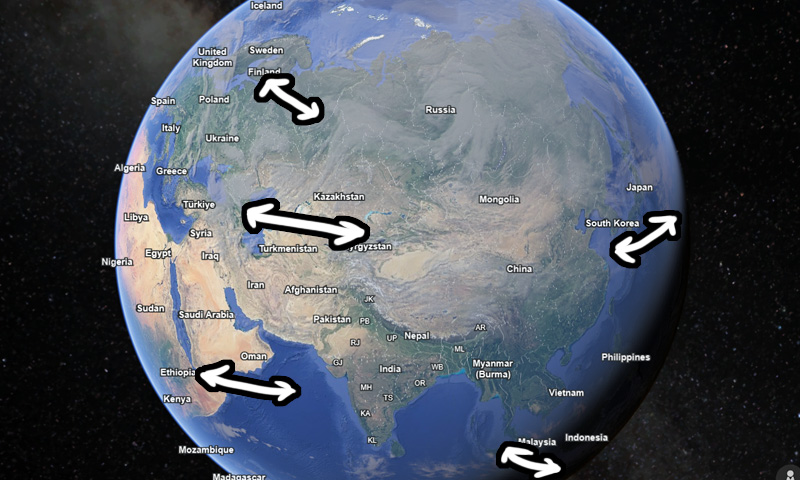
Flightless Travel in Asia
As the largest continent, Asia provides excellent opportunities for flightless travel. However, political tensions and border issues can present obstacles.
How to Get Around Asia without Flying
Asia boasts some of the best train networks in the world. Although currently (early 2024) unavailable, the Trans-Mongolian railway has taken passengers from Europe to China in less than a week. China has greatly improved its high-speed train network in recent years and India is still one of the best destinations for train enthusiasts. Long-distance buses, cargo ships, and even river boats contribute to a diverse range of transportation modes.
Despite these advantages, flightless travel between Asian countries can be hindered by geopolitical issues. Travel through Russia, parts of Central Asia, and certain Middle Eastern regions may be challenging or unsafe. Azerbaijan remains closed, but at least China reopened its borders in 2023.
Still, regions like Southeast Asia and the Indian Peninsula offer great overland routes for flightless exploration. I explored the potential of these regions during my mostly flightless world tour by spending a month in India before crossing the border to Nepal and later covering a lot of Southeast Asia on public transport.
Flightless Travel to/from Asia
Being part of the same continental area, one might expect lots of flightless travel opportunities between Europe and Asia. However, challenges arise, with previous major routes affected by global events.
I have previously written a guide on how to travel from Europe to Asia without flying. However, situations in this area change rapidly, and you should always check the most recent information about the area.
In the past, there have been four major travel routes from Europe to Asia: Russia, Central Asia, the classic Hippie trail in the south and sea travel across the Suez Channel. At the time of writing in 2024, all these routes face disruptions.
Traveling in Russia is heavily discouraged by many countries, and the Trans-Mongolian railway to China is not operating. Passing through Azerbaijan in Central Asia is not possible, and border crossings between Kyrgyzstan and Tajikistan are limited. Traveling through Afghanistan and Pakistan has been unsafe for a long time, and the turmoil related to the crisis in Israel and Palestine has limited seafaring in the Red Sea.
Freighter travel company Slowtravel has offered a few cargo ship voyages between Africa and Asia. Sailing from Africa to Asia is not common, but according to Cruiserwiki, sailing from Southeast Asia to Africa is an option.
Crossing the Pacific Ocean between Asia and America, while time-consuming, is possible. For example, Slowtravel offers a 19-day freighter cruise from Vietnam to Los Angeles, costing around $2300.
Journeying between Southeast Asia and Australia without flying presents challenges. I’ve covered these issues in my previous guide “How to Get to Australia without Flying“.

How to Travel the World without Flying: Australia and Oceania
Remember: flat map projections distort reality. Although some maps may show otherwise, Australia is absolutely massive. It is also very sparsely populated outside its coastal regions. Meanwhile the rest of Oceania is popular with sailors, but long distances make flightless travel a challenge.
Traveling in Australia and Oceania without Flying
Australia’s extensive distances limit public transport access, but Greyhound coaches cover most major destinations. rains, though expensive, connect eastern destinations as well as Perth in West Australia and Darwin in the Northern Territory.
I’ve spent six weeks in Australia, and I had great experiences with overland travel. I liked my overnight Greyhound bus ride from Adelaide to Alice Springs in Central Australia. I met many travelers who bought or rented cars to explore the country, and I even encountered a backpacker who had cycled through the Australian Outback.
New Zealand is easy to explore on public transport, and I also found it easy to hitchhike in the North Island. Smaller island countries of Oceania, however, pose challenges with few visitors, long distances and infrequent travel opportunities.
Countries like Fiji are popular with sailors and other visitors. Some countries offer ferries connecting their islands, but the distances can be long and ships don’t leave every day. Navigating Oceania requires preparation for delays and uncertainties.
For instance, I couldn’t board a ferry from Tonga’s main island Tongatapu to the island of Ha’apai because the 13-hour journey was fully booked by mormons heading to a massive religious gathering. In other words: be flexible.
Getting to and Leaving Oceania by Ship
Getting to Australia is not as easy as one might hope. Despite the short distance, getting from Asia to Australia on a ship is not easy. I have covered flightless ways to travel to Australia in my previous guide “How to Get to Australia without Flying“.
When I traveled from New Zealand to California on a cargo ship, the same ship also traversed between New Zealand and Australia. Unfortunately COVID is limiting cargo ship travel at the time of writing.
South Pacific islands, though widely dispersed, attract sailors. You can try to work for your passage through websites like Findacrew.net and CrewSeekers.net. Sailing from the Americas to Oceania via French Polynesia is more common than crossing the Pacific from west to east.
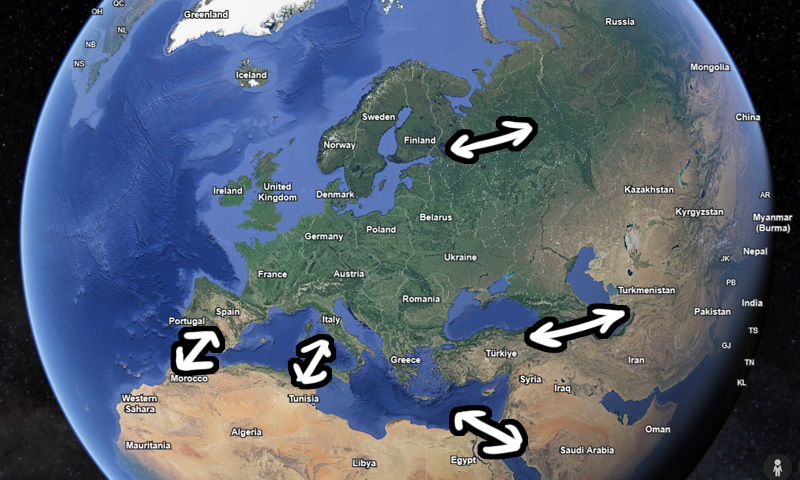
How to Travel the World without Flying: Europe
If you ask me, Europe stands out as a paradise of overland travel. No other place has as many different countries in such a small area, and border crossings – especially within the European Union – are very easy.
How to Travel in Europe without Flying
If you’re a flightless traveler from Europe, you already know of InterRail. The InterRail ticket has allowed travelers to explore most European countries by train on a single travel pass. EURail is a similar pass for people from other countries.
I have done two InterRail trips in the past (a.k.a. the one where I got mugged and the one with the ambitious dream-gathering project) and I love the system, but I don’t think it’s the best way to explore Europe. Many popular routes require extra bookings, and long-distance coaches, exemplified by FlixBus, offer competitive deals, particularly when booked in advance.
Some European train connections are very fast, but not all routes are equal. For example, traveling through Eastern Europe can take much longer than expected.
I have previously written several guides that explore flightless travel in Europe:
- How to Get to England without Flying
- How to Travel to Finland without Flying
- How to Travel to Iceland by Ship
- How to Get to Portugal without Flying
- How to Get to Spain without Flying
Flightless Travel Between Europe and Other Continents
My previous guides cover flightless travel between Europe and the rest of the world. My guide “How to Get to Europe without Flying” covers routes to Europe. I have also written specific guides for crossing the Atlantic, as well as traveling from Europe to Africa, Asia, and Australia.
Unfortunately changing global situations, such as COVID-related restrictions and geopolitical tensions, impact these routes. Routing through Russia, the southern Hippie trail, and sea travel across the Suez Canal have faced disruptions. Political instability affects travel in Northern Africa and Central Asia.
Consult up-to-date sources when planning flightless travel in the region.

How to Travel the World without Flying
This guide has delved into flightless travel possibilities across the globe. You can use it to study how to travel the world without flying. And if you’re more ambitious, you can combine the advice to plan a flightless trip around the world.
Embarking on a world tour necessitates two main methods: overland travel and ocean crossings. Overland travel is relatively straightforward in regions like Australia, Europe, and North America. Some parts of Asia and South America can also work well, although you might hit roadblocks in specific regions.
Ocean crossings can be a great challenge. There are many ways to cross the Atlantic, and crossing the Pacific is also possible. At the same time, even short sea routes – such as traveling between Southeast Asia and Australia – can be surprisingly difficult.
The Northern Hemisphere generally provides easier routes, while travel in the Southern Hemisphere may be more challenging. For example, traveling from North America to Europe is far more common than heading from South America to Africa.
In a way, I planned this text as the ultimate guide on how to travel the world without flying. It covers all the regions of the world, but it is not fully comprehensive. I focused on providing a broad overview to maintain readability.
I hope this guide, along with my other articles, aids in planning your flightless adventures around the world!




